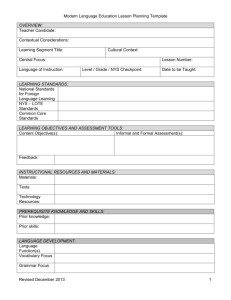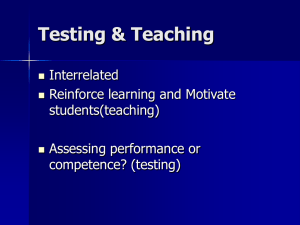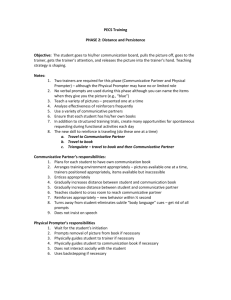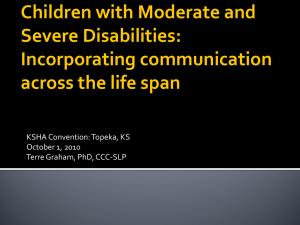Analysis of Classroom Communication
advertisement
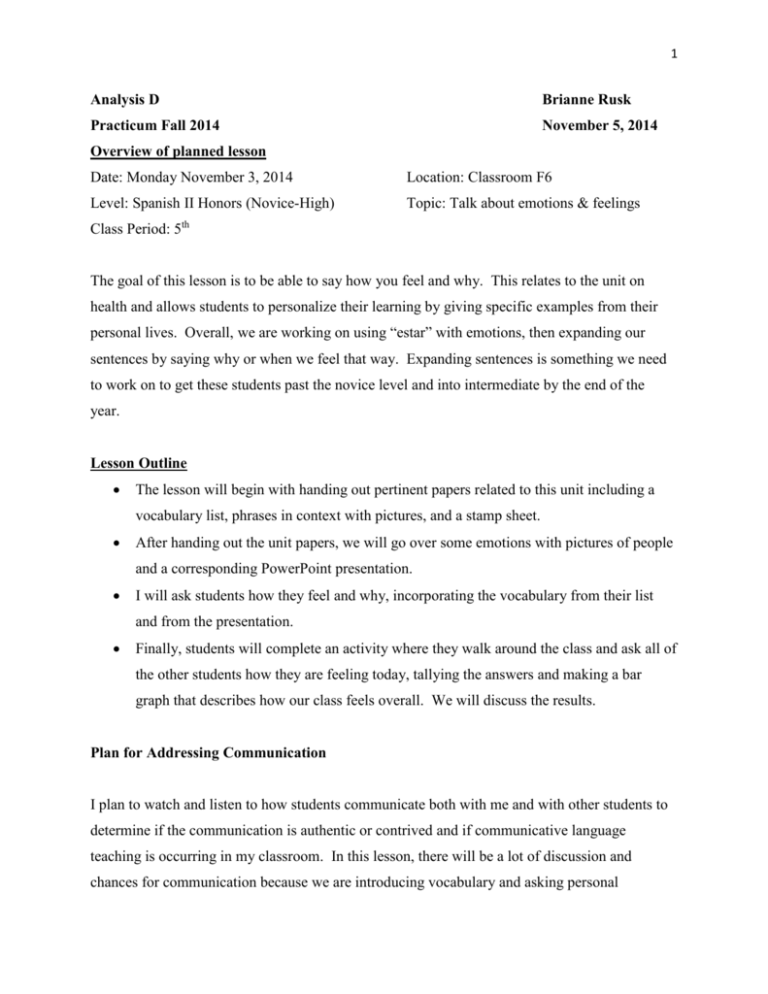
1 Analysis D Brianne Rusk Practicum Fall 2014 November 5, 2014 Overview of planned lesson Date: Monday November 3, 2014 Location: Classroom F6 Level: Spanish II Honors (Novice-High) Topic: Talk about emotions & feelings Class Period: 5th The goal of this lesson is to be able to say how you feel and why. This relates to the unit on health and allows students to personalize their learning by giving specific examples from their personal lives. Overall, we are working on using “estar” with emotions, then expanding our sentences by saying why or when we feel that way. Expanding sentences is something we need to work on to get these students past the novice level and into intermediate by the end of the year. Lesson Outline The lesson will begin with handing out pertinent papers related to this unit including a vocabulary list, phrases in context with pictures, and a stamp sheet. After handing out the unit papers, we will go over some emotions with pictures of people and a corresponding PowerPoint presentation. I will ask students how they feel and why, incorporating the vocabulary from their list and from the presentation. Finally, students will complete an activity where they walk around the class and ask all of the other students how they are feeling today, tallying the answers and making a bar graph that describes how our class feels overall. We will discuss the results. Plan for Addressing Communication I plan to watch and listen to how students communicate both with me and with other students to determine if the communication is authentic or contrived and if communicative language teaching is occurring in my classroom. In this lesson, there will be a lot of discussion and chances for communication because we are introducing vocabulary and asking personal 2 questions about feelings and emotions. They will also do a questioning activity with their other classmates to find out how they are feeling. I think this lesson is set up well do discover what kind of communicative environment I am creating. Core Statements about Communicative Language Teaching Statement Second language learning is facilitated when learners are engaged in interaction and meaningful communication. Meaningful communication results from students processing content that is relevant, purposeful, interesting, and engaging. Communication is a holistic process that often calls upon the use of several language skills or modalities. Language learning is a gradual process that involves creative use of language, and trial and error. The role of the teaching in the language classroom is that of a facilitator who creates a climate conducive to language learning and provides opportunities or students to use and practice the language and to reflect on language use and language learning. The classroom is a community where learners learn through collaboration and sharing. Activities center on communicative functions and contextualization is a major premise. Focus on form is contextualized and has a purpose for communication. Implementation in my classroom During this lesson, communication was meaningful and authentic because we talked about the students’ real feelings and things that are actually happening in their lives. Teenaged students are usually very engaged when talking about themselves and their lives. They were especially engaged when complaining about their parents and how they feel about school during this lesson. Students were required to listen to teacher input, make statements about feelings, tell why they felt that way, and later on, ask others how they felt and why. Although this lesson did not include much reading or writing, those skills are incorporated on a regular basis. Mistakes are encouraged in communication. The most important thing is that they are trying to communicate in Spanish. Creative use was witnessed in this lesson when students said things in the TL that they have never said or heard before about why they felt the way they did. I created a climate conducive to language learning by using the TL 95% of class time during this lesson. Students got opportunities to practice the language when they shared their feelings and asked about the feelings of others. Students shared their feelings with the class as a whole, and then shared one on one with their classmates, collaborating to determine how our class felt as a whole that day. The communicative function in this lesson was saying how one feels and why, not how to use the verb estar. This gave the activity context. The form being utilized here was the verb estar, which was contextualized through communicating about feelings and emotions. 3 Comprehensible pronunciation is sought. Judicious use of native language is employed. There is a focus on student personalization. Students are expected to interact with other people through pair and group work. We used the form instead of teaching it in a decontextualized manner. During choral repetition of the vocabulary, I stopped the lesson a few times to point out pronunciation aspects and correct group pronunciation. I used 95% Spanish during this lesson and students also used a majority of Spanish. With me, they probably used 90%, but with each other it was certainly lower. The majority of the class, however, was conducted in the TL. Students were able to personalize their TL use by making statements about themselves, their lives, and their feelings. Students are seated in groups of four to encourage interaction. During this lesson, they interacted with me and with the other students in the class when they questioned everyone about how they felt that day. Reflection Based on the statements provided in the syllabus for this class, I would characterize communicative language teaching as an approach to language teaching that emphasizes interaction and communication. Meaningful and contextual communication is the key, and often forms are hidden within the contextual input. Students should be able to communicate about topics that are relevant and interesting to them and that will keep them engaged. Also, errors are common and a normal part of the communicative process; however, these errors are not chastised or penalized. They are seen as a natural part of language learning. The role of the teacher is to facilitate this natural, contextual communication in a positive, collaborative environment while encouraging attempts to communicate in the target language and motivating students to achieve communicative proficiency. Based on evidence from this lesson, I am proud to say that I believe communicative language teaching is occurring in my classes. This lesson on feelings and emotions was communicative in that it allowed for students to share personal information in a contextualized way. They were able to talk about how they feel and why, which they found interesting and engaging based on 4 their level of participation. The forms of the verb estar were hidden within the lesson’s context, and students got to practice those forms without them being the main focus of the lesson. Another great thing about this lesson was that the students were able to collaborate and share with their peers, learning from one another. The lesson was almost entirely in the target language, by me and the students, and although their Spanish production was not perfect, they were not penalized for their errors, but encouraged to participate and try out new language. One of the things I liked most about this lesson was that the communication was authentic. In a traditional IRE lesson, questions and responses are often inauthentic, or contrived. The questions are often checking for understanding or requesting a verbalization of learned information. This lesson was less traditional with more authentic communication due to the nature of the questioning. Questions were personalized and answers could vary from student to student. The goal was not necessarily accuracy, but information transfer, with follow-up questions and discussion of student answers. Students are more engaged when they are able to communicate useful, interesting information rather than simply repeating from a textbook or giving an answer that they know is being grammatically dissected. Overall, I was pleased to find that this lesson met the standards for communicative language teaching. Its authentic communicative nature and the amount of target language input and output in the lesson made it not only engaging for the students, but also beneficial to their language acquisition. Of course, not all lessons are so orally focused; therefore my challenge is to make each day communicative, regardless of the mode of communication used. Communicative language teaching does not have to simply refer to oral communication, but instead must involve authentic and contextual communication within real-world situations that the students find engaging and useful to their real lives. Source Cazden, C.B. (2001). Classroom discourse: The language of teaching and learning (2nd ed.). Portsmouth, NH: Heinemann.

